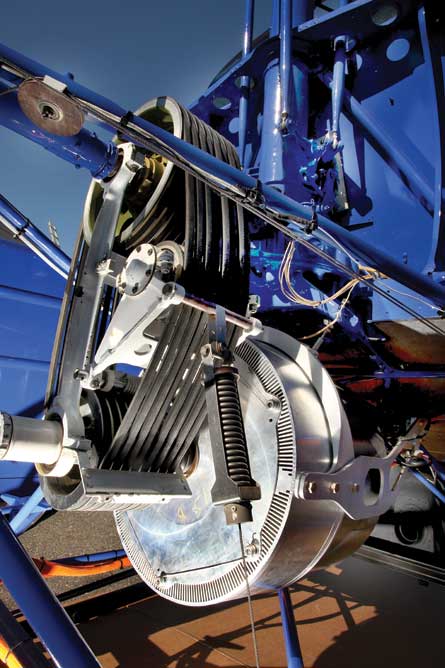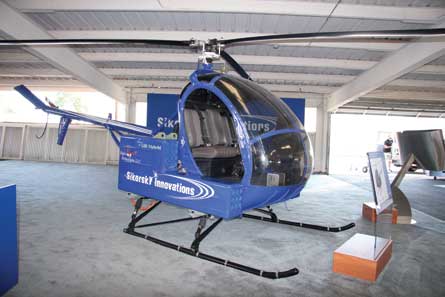Sikorsky will not say exactly when, but at some point this year a test pilot will enter a company-owned Schweizer S-300C and do something never attempted before. Observers may not notice anything different about this particular S-300C. Even the pilot should not notice anything significantly different until the moment he would normally hear the clutch engage the rotor. That is the audible cue signalling to the pilot that his helicopter is ready to take off.
Instead of that familiar sound, the test pilot should hear nothing.
This will be the first flight of the Firefly, the first manned helicopter lacking both an engine and gasoline. It is powered by an electric motor fed by battery cells.
 |
|---|
© Sikorsky |
The design was inspired by a drag-racing motor powered by lithium polymer battery cells |
"We did a full one-to-one swap of the drive train," Jonathan Hartman, an advanced concepts engineer for Sikorsky Innovations, said.
"We took out the engine, the fuel system, all the associated electrical [equipment] that wasn't necessary, and we replaced that with an electric-powered system, which is an electric motor, its controller and then the battery boxes." Mass production of battery-powered helicopters is not quite around the corner, but it is getting closer.
Fixed-wing flight has embraced electric power faster.
UNIQUE PROPULSION
Cessna has launched a demonstration of an electric-powered Cessna 172. EADS has flown the all-electric Cri-Cri aerobatic aircraft. Yuneec is building the e430 all-electric aircraft for the general aviation market.
However, Sikorsky arguably has a dramatically harder challenge. Helicopters have unique propulsion requirements that have so far proven too excessive for battery technology. The first goal of the Firefly experiment is "just demonstrating a proof-of-concept feasibility of a manned electric helicopter," Hartman said.
"First flight, getting rotors off the ground is an important step to us and then I'll say less splash to the public. But obviously very important to us is safe flight operation, ensuring the health-monitoring system is working properly and identifying the issues that are unique to an electric aircraft flight test.
"We've never had something like this. There's obviously going to be handling instruction and just general maintenance that will come up," he added.
About three years ago, Chris Van Buiten, a Sikorsky technical fellow, visited a drag race where one competitor was the "White Zombie", a 1972 Datsun 1200 coupe modified with an electric motor powered by lithium polymer battery cells. In a contest between present and future, the White Zombie lined up to race a gas-powered hot rod. "The [gas-powered] drag racer was revving his engine and getting the crowd worked up, and Chris said the other guy was in this little white car with this serene smile on his face. [He was] just humming along, waiting," Hartman said.
"As soon as the green light hit, this electric car took off like a banshee [and] beat this drag racer down the strip."
The White Zombie clearly made an impression. It was powered by two electric motors, each generating about 200hp. Van Buiten considered that one of Sikorsky's light utility helicopters - the Schweizer S-300C - is propelled by a 190hp engine. Hartman recalled how the Firefly was conceived. "We showed up on a Monday morning and Chris asked: 'What's the feasibility of doing something like this?'"
 |
|---|
© Sikorsky |
The Firefly should "look, feel and fly" like a standards Schweizer S-300C |
In some respects, a conventional helicopter's propulsion system is not a huge departure from that of a drag racer. The White Zombie race only lasted 15s but the motor was running at full power continuously. Like most conventional helicopters, the S-300C engine is required to deliver maximum power during take-off, hover and landing modes.
"Whereas in a normal battery profile you can use less power over time - and that's what it likes to do - we have to save that power towards the last minute of the flight as well as for hover," Hartman said. "So you have to have something in the tanks to come back and land." If it is possible for the White Zombie to maintain continuous maximum power for 15s driven by lithium polymer battery cells, Sikorsky's challenge for a helicopter proof-of-concept demonstration was to increase that endurance to 15min, or by an order of magnitude.
The state of the White Zombie after the drag race illustrated the scale of the challenge.
"This guy was actually dripping metal off his car when he was done with it - the batteries and the motors were getting so warm," Hartman said. "These were all the challenges we've ended up overcoming."
Sikorsky was careful to limit the number of technical risks involved in the Firefly demonstration. "We really wanted this aircraft to look, feel and fly like a standard -300," Hartman said. "In order to get us to first flight more quickly, and to focus attention on the electric propulsion side of it, we wanted to keep it as much like a -300C as possible."
Sikorsky prefers to keep many details secret but some major changes from the White Zombie are evident. Firstly, Sikorsky replaced lithium polymer cells with lithium ion as the battery power source. Lithium polymer is starting to find wide applications in consumer electronics, even in the automotive industry, but the battery technology is still deemed for aerospace applications - especially helicopters.
"The real reason we chose these particular lithium ion cells was for safety and reliability which are big concerns for us in the aviation industry," Hartman said. "I use the analogy with the electric bus - it can stop [if the battery fails]. It doesn't impact you other than you have to find a new bus. If the batteries, you know, kill their power early on a rotorcraft you have a much bigger problem to deal with."
The Firefly is classified as a demonstrator - not a prototype. How long it will take for battery-powered helicopters to make the production line is likely to be paced by the progress of a single metric - energy density. Battery packs in the Firefly weigh about 531kg (1,170lb), with an energy density of about 150 Watt-hours per kilogram (Wh/kg). This provides maximum endurance of about 15min. The same helicopter with a combustion engine and full fuel load can remain airborne for about 2h.
Some aviation experts think battery-powered aircraft will not become practical until batteries deliver 5,000Wh/kg. If all things, including airframe and engine size, are equal, only then will electricity compete evenly with gasoline as a power source. Sikorsky, however, thinks there may be a way around this equation to deliver electric aircraft to the market faster. It may not be necessary to wait for battery cells to produce power at 5,000Wh/kg.
"When you remove the motor, you do things like reduce noise, you reduce airframe vibration, which allows you to be more creative in a future project as to how you use structure. You reduce cost," Hartman said.
MORE ELECTRIC
"Electric aircraft are inherently less complex than something like a turbine aircraft. So it's really quantifying those benefits, then being able - not only technically, but at a cost level and operating cost level to a customer - to really start engaging that community," he added.
For manufacturers such as Sikorsky, the benefits of electric power do not have to wait for a new kind of aircraft to be applied. Fixed-wing and rotary-wing aircraft are increasingly becoming "more electric" internally, from the electro-hydrostatic actuators replacing hydraulics as the primary power source on the flight controls of the Lockheed Martin F-35, to the integrated engine starter/generator replacing bleed air on the Boeing 787.
Long before the new aircraft emerges from Sikorsky's final assembly line in Stratford, Connecticut a whole new approach to designing systems may emerge from the company's advanced concepts division.
"We use this data not only for propulsion technologies but how it applies to the whole aircraft," Hartman said.
"If you're not on every [research and development] project looking at the numerous ways across the board at both the subsystem and the system level, you're not taking full advantage of results of your research."
If you would like to watch the Firefly's unveiling during last year's Oshkosh, visit flightglobal.com/firefly
Source: Flight International























